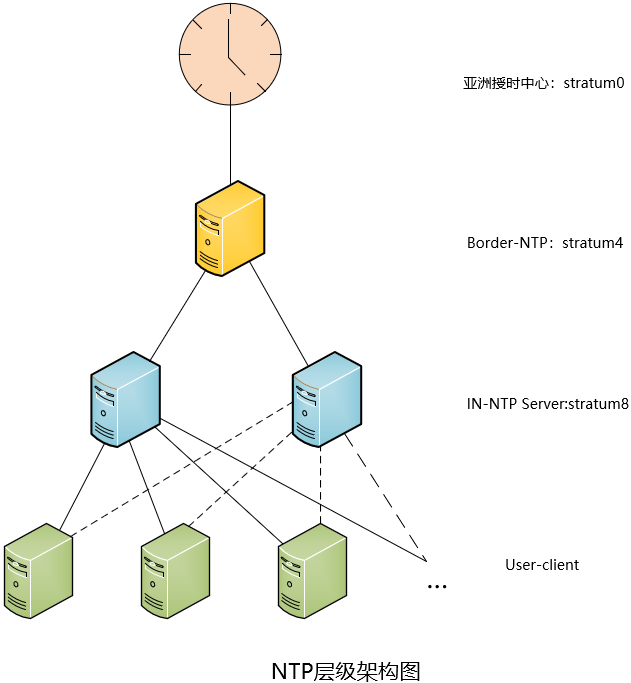004.NTP多层级架设
一 环境需求
1.1 需求
User-client:局域网所有节点主机;
IN-NTP Server:隐藏于局域网内部的NTP服务器;
Border-NTP:边界NTP服务器,用于同步外部时钟,同时对内部IN-NTP服务器提供校对;
亚洲授时中心:公网NTP授时中心。
内部局域网所有节点client需要和IN-NTP Server同步,IN-NTP Server对外隐藏,同时通过 Border-NTP进行同步, Border-NTP边界NTP服务器实时同步公网授时中心。
1.2 架构
注意:
- Border-NTP部署在边界上,作为和互联网(亚洲授时中心)同步,同时为局域网内部IN-NTP提供同步服务。
- User-client,包括所有局域网内客户端等,从两台(一主一备)IN-NTP进行同步。
二 Border-NTP配置
2.1 服务包安装
1 [root@border_ntp ~]# rpm -qa | grep ntp 2 [root@border_ntp ~]# yum -y install ntp #安装ntp服务
2.2 ntp配置
1 [root@border_ntp ~]# vi /etc/ntp.conf 2 driftfile /var/lib/ntp/drift 3 #定义与上级时间服务器联系时所花费的时间,记录在driftfile参数后面的文件内。 4 driftfile /var/lib/ntp/drift 5 pidfile /var/run/ntpd.pid #进程pid文件 6 logfile /var/log/ntp.log #开启日志记录 7 #定义与上级时间服务器联系时所花费的时间,记录在driftfile参数后面的文件内。 8 9 restrict default nomodify notrap nopeer noquery #默认拒绝所有NTP连接 10 restrict 127.0.0.1 11 restrict ::1 #开启本地授权 12 13 restrict 172.24.8.72 mask 255.255.255.255 nomodify notrap #添加IN-NTP Server允许校时 14 restrict 172.24.8.73 mask 255.255.255.255 nomodify notrap #添加IN-NTP Server允许校时 15 16 #server 0.cn.pool.ntp.org 17 #server 1.asia.pool.ntp.org 18 #restrict 0.cn.pool.ntp.org nomodify notrap noquery 19 #restrict 1.asia.pool.ntp.org nomodify notrap noquery 20 #添加Border-NTP的上一级时间中心,即亚洲授时中心服务器,此处建议注释,转而采用国内阿里云时钟,相对网络更稳定,如下。 21 server ntp1.aliyun.com iburst minpoll 4 maxpoll 10 22 restrict ntp1.aliyun.com nomodify notrap nopeer noquery 23 server ntp2.aliyun.com iburst minpoll 4 maxpoll 10 24 restrict ntp2.aliyun.com nomodify notrap nopeer noquery 25 #允许阿里授时中心修改本地时间。 26 server 127.127.1.0 27 fudge 127.127.1.0 stratum 4 28 #当授时不可用,采用本地时间,stratum级别为4。
2.3 其他配置
1 [root@border_ntp ~]# chown ntp:ntp /var/log/ntp.log 2 [root@border_ntp ~]# chcon -t ntpd_log_t /var/log/ntp.log 3 [root@border_ntp ~]# firewall-cmd --permanent --add-service=ntp 4 [root@border_ntp ~]# firewall-cmd --reload 5 [root@border_ntp ~]# setenforce 0
提示:若开启日志功能,需要ntp进程具备写入日志权限。同时防火墙开放ntp服务,SELinux写入上下文授权。
建议:若没有特殊必要,建议关闭SELinux和防火墙。
2.4 开启服务
1 [root@border_ntp ~]# systemctl start ntpd.service 2 [root@border_ntp ~]# systemctl enable ntpd.service
提示:开启ntp server后,需要等待一定时间(通常为5分钟以内),才能实现和亚洲授时中心的同步。
2.5 验证
1 [root@border_ntp ~]# ntpq -np提示:ntpq相关含义见附录一。
三 IN-NTP Server配置
3.1 服务包安装
1 [root@in_ntp01 ~]# rpm -qa | grep ntp #查看是否安装ntp 2 [root@in_ntp01 ~]# yum -y install ntp #安装ntp服务
3.2 ntp配置
1 [root@in_ntp01 ~]# vi /etc/ntp.conf 2 driftfile /var/lib/ntp/drift 3 pidfile /var/run/ntpd.pid #进程pid文件 4 logfile /var/log/ntp.log #开启日志记录 5 #定义与上级时间服务器联系时所花费的时间,记录在driftfile参数后面的文件内。 6 tinker stepout 0 7 restrict default ignore #默认拒绝所有连接 8 restrict -6 default ignore #默认拒绝所有ipv6连接 9 restrict 127.0.0.1 10 restrict -6 ::1 #开启本地授权 11 12 restrict 172.24.8.0 mask 255.255.255.0 nomodify notrap #允许局域网内网段校时 13 14 restirct 172.24.8.71 nomodify notrap nopeer noquery 15 #允许根据上一级时间修改本地时间 16 server 172.24.8.71 iburst minpoll 3 maxpoll 3 prefer 17 #添加上一层Border-NTP服务地址 18 19 #peer 172.24.8.72 iburst minpoll 4 maxpoll 6 20 #peer 172.24.8.73 iburst minpoll 4 maxpoll 6 21 #服务器接收其他服务器的地址,同时也会为其他设备提供NTP服务器,即互相同步,用于在孤岛环境中,若同时具备上层时钟,可注释掉。 22 23 server 127.127.1.0 24 fudge 127.127.1.0 stratum 8 #上一级不可用,使用本地时间,stratum为8
3.3 其他配置
参考2.3.
3.4 开启服务
1 [root@in_ntp01 ~]# systemctl start ntpd 2 [root@in_ntp01 ~]# systemctl enable ntpd
3.5 验证
1 [root@in_ntp01 ~]# ntpq -np注意:两台IN-NTP Server都需要配置。
四 user-client配置
4.1 服务包安装
1 [root@client ~]# rpm -qa | grep ntp #查看是否安装ntp 2 [root@client ~]# yum -y install ntp #安装ntp服务
4.2 ntp配置
1 [root@client ~]# vi /etc/ntp.conf 2 driftfile /var/lib/ntp/drift 3 pidfile /var/run/ntpd.pid #进程pid文件 4 logfile /var/log/ntp.log #开启日志记录 5 #定义与上级时间服务器联系时所花费的时间,记录在driftfile参数后面的文件内。 6 7 tinker panic 600 8 #当client和server时差在600秒以内,使用渐变调整client时间,超过600秒,ntpd进程自动终止,需要手动进行调整。 9 restrict default ignore #默认拒绝所有连接 10 restrict -6 default ignore #默认拒绝所有ipv6连接 11 restrict 127.0.0.1 #开启本地授权 12 13 restrict 172.24.8.72 nomodify notrap noquery #允许根据上一级时间修改本地时间 14 restrict 172.24.8.73 nomodify notrap noquery #允许根据上一级时间修改本地时间 15 16 server 172.24.8.72 iburst minpoll 4 maxpoll 6 prefer 17 server 172.24.8.73 iburst minpoll 4 maxpoll 6
4.3 其他配置
参考2.3.
4.4 开启服务
1 [root@client ~]# systemctl start ntpd 2 [root@client ~]# systemctl enable ntpd
4.5 验证
1 [root@client ~]# ntpq -np 1 [root@client ~]# ntpstat附录一
ntpq参数解释:
remote:本地服务器所连接的远程NTP服务器。
refid:NTP服务器使用的上一级ntp服务器,即给远程ntp服务器提供时间同步是服务器。。
st :remote远程服务器的级别,由于NTP是层型结构,有顶端的服务器,多层的Relay Server再到客户端。所以服务器从高到低级别可以设定为1-16,为了减
缓负荷和网络堵塞,原则上应该避免直接连接到级别为1的服务器的。
when: 上一次成功请求之后到现在的秒数。
poll : 本地机和远程服务器多少时间进行一次同步(单位为秒),在一开始运行NTP的时候这个poll值会比较小,那样和服务器同步的频率也就增加了,可以尽快调
整到正确的时间范围,之后poll值会逐渐增大,同步的频率也就会相应减小。
reach:这是一个八进制值,用来测试能否和服务器连接,每成功连接一次它的值就会增加
delay:从本地机发送同步要求到ntp服务器的round trip time
offset:主机通过NTP时钟同步与所同步时间源的时间偏移量,单位为毫秒(ms)。offset越接近于0,主机和ntp服务器的时间越接近。
jitter:这是一个用来做统计的值,它统计了在特定个连续的连接数里offset的分布情况,简单地说这个数值的绝对值越小,主机的时间就越精确。
『 * 』:代表目前正在作用当中的NTP,即主NTP Server;
『 + 』:代表辅助的NTP Server和带有*号的服务器一起为我们提供同步服务, 当主NTP Server服务器不可用时备服务器接管,即作为下一个提供时间更新的候
选者。
『 - 』:远程服务器被认为是不合格的NTP Server。
『 x 』:远程服务器不可用。
附录二
ntp服务,默认只会同步系统时间。若需要ntp同时同步硬件时间,可以在/etc/sysconfig/ntpd文件中,添加 SYNC_HWCLOCK=yes ,则可以让硬件时间与系统时间一起同步。
SYNC_HWCLOCK=yes
注意:允许BIOS与系统时间同步,也可以通过hwclock -w 命令。
作者:木二
出处:http://www.cnblogs.com/itzgr/
关于作者:云计算、虚拟化,Linux,多多交流!
本文版权归作者所有,欢迎转载,但未经作者同意必须保留此段声明,且在文章页面明显位置给出原文链接!如有其他问题,可邮件(xhy@itzgr.com)咨询。






